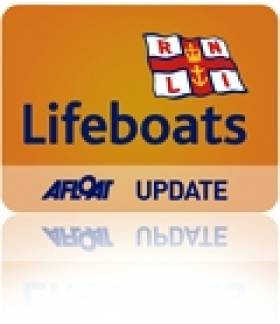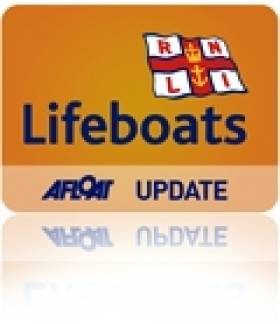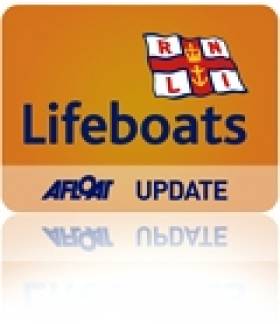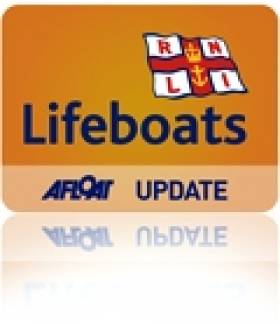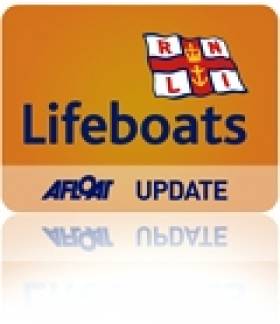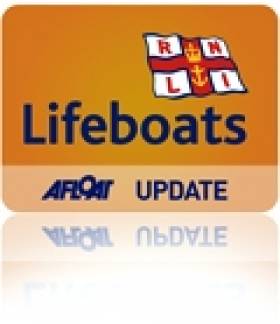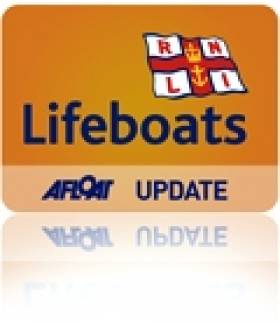Displaying items by tag: Wicklow
Wexford, Wicklow and Courtown Lifeboats Have A Busy Few Days
#RNLI - Wexford RNLI rescued two people late on Monday night (26 August) after their yacht went aground on a sandbank on the way into Wexford Harbour.
The volunteer lifeboat crew responded to the report of the yacht which had grounded near Ravens Point around midnight on Monday. Weather conditions at the time were good with a calm sea state and a north westerly force three wind.
But a fast-flowing tide of four knots meant that the inshore lifeboat and crew of the yacht had to work hard to refloat that boat.
Wexford RNLI lifeboat helm Peter Scallan commended the action of the yacht's crew, who he said were experienced sailors.
"The yacht's crew had taken all the correct precautions with the appropriate equipment on board to ensure their safety. They co-operated greatly with the lifeboat crew and as a result both they and their yacht were rescued."
Lifeboat crew member Alan Keville went onboard the vessel to assist in the manoeuvre to get the yacht off the sandbank, which involved using the mast to get the vessel on its side as the keel was stuck hard in the sandbank. The yacht was under tow at 1.14am and back in Wexford at 2.30am.
Elsewhere, the Courtown lifeboat launched on Sunday afternoon (25 August) to a report of a swimmer missing off Ardamine beach.
The lifeboat crew, who were in the harbour at the time, launched within minutes and commenced a search of the area. Irish Coast Guard helicopter Rescue 117 was also tasked to the scene, along with the Courtown coastguard unit.
After a thorough search of the area between Glasscarrig and Courtown pier, all rescue services were stood down as nothing was found. Courtown RNLI thanked all the members of public who helped and provided information during the call out.
The day before, the Wicklow RNLI inshore and all-weather lifeboats were launched after a member of the public reported seeing a small craft with two people drifting off Brittas Bay beach.
While the lifeboats were on route to Brittas Bay, they were requested to stand down and return to station by the coastguard as the boaters managed to make their own way ashore.
Speaking after the call-out, Wicklow RNLI lifeboat operations manager Des Davitt said: "While this turned out to be a false alarm with good intent, we are delighted that the public are being vigilant and contact the coastguard immediately when they suspect someone is in trouble on the water."
Wicklow RNLI Remembers Historical Greystones Lifesaver
#RNLI - Wicklow RNLI travelled to Greystones on Sunday afternoon (18 August) for the unveiling of a plaque in memory of RNLI coxswain John Doyle and two members of his family, who lost their lives in 1892.
The deceased were trying to assist a vessel breaking away from her moorings in Greystones Harbour on 14 October 1892, a Friday night when heavy seas and a north-east gale prevailed in the Irish Sea.
That night, the schooner Mersey, which was moored alongside the jetty at Greystones, threatened to break up where she lay, and the owner resolved to let her drive on the beach.
John Doyle and William Doyle - with Herbert Doyle, son of the latter - went out along the jetty to cast a rope to the vessel and, having done so, were making their return when a great wave suddenly engulfed them. They had often gone out to save life and were famed for their bravery.
John and William Doyle left large families, and there were many tearful eyes at the funeral service in St Patrick's Church for the three Doyles, many of whose descendants are still in Greystones.
The Anchor amusement centre and restaurant at the harbour was originally a lifeboat house, and between 1871 and 1896 there were two lifeboats, the Sarah Tancred and the Richard Brown, the latter of which John Doyle served as coxswain.
As the Wicklow lifeboat entered Greystones, the crew scattered flower petals inside the harbour entrance as a mark of respect for coxswain Doyle.
John Doyle’s granddaughter Betty Lowe unveiled the plaque on the pier wall. During the ceremony, the lifeboat crew presented her with a framed photograph of the Wicklow lifeboat and an RNLI flag.
Lowe was inspired to erect the memorial after attending the unveiling of The Beacon of Hope sculpture in 2009 at the RNLI headquarters in Poole. Her grandfather’s name is one of hundreds on the memorial who have given their lives selflessly to save others over the last 200 years.
Speaking after the ceremony, Wicklow RNLI volunteer lifeboat press officer Tommy Dover said: "We would like to thank Mrs Lowe and her family for inviting us to the ceremony, it was a great privilege to be involved."
Wicklow RNLI Lifeboat Diverts From Exercise For Call-Out
#RNLI - Both Wicklow lifeboats were diverted to Brittas Bay last Sunday morning (11 August) while on a routine exercise in the bay.
At 10.57am the Irish Coast Guard tasked the lifeboats to investigate a report of a small motor boat with two people drifting off the beach.
A member of the public had raised the alarm, as they believed the occupants might be in need of assistance.
As the lifeboats were proceeding to the small boat, they were stood down by the coastguard after it was ascertained that the two people were fine and able to return to shore under their own power.
The lifeboats then resumed exercise in the Wicklow bay area.
Speaking after the incident, Wicklow RNLI volunteer lifeboat press officer Tommy Dover said: "This was volunteer crew member Alan Goucher’s first call-out as a helm in charge of the inshore lifeboat and Connie O'Gara’s first call-out on the all-weather lifeboat as a mechanic."
Busy Thursday For Wicklow & Wexford Lifeboats
#RNLI - It was a busy afternoon for RNLI lifeboats on the east coast on Thursday 8 August with separate call-outs in Wicklow and Wexford.
Wicklow RNLI's all weather lifeboat Annie Blaker was launched at 3.15pm to answer a call for assistance from a lone yachtsman experiencing mechanical difficulties off Wicklow Head.
As the crew assembled at the station, another call for assistance was received from a boat with four people in the same area.
The lifeboat launched immediately and located the small boat with four on board near Brides Head a short time later, but the occupants were in no immediate danger, so no further assistance was required as the boat was able to return safely to more sheltered waters under its own power.
The lifeboat then proceeded to the stricken yacht, located about two miles east of Wicklow Head shortly after 3.30pm. Weather conditions in the area at the time were described Force 4 with a south west wind.
The boat with the lone sailor was escorted back to Wicklow by the lifeboat. One of the lifeboat crew was transferred onto the yacht outside the harbour to assist with mooring the boat alongside the east pier.
Meanwhile in Co Wexford, the volunteer lifeboat crew at Rosslare Harbour RNLI launched their all weather lifeboat at 11am to assist an 11-metre fishing boat in difficulty.
The Arklow boat became entangled in fishing gear while north of Raven Point on the Wexford coast and lost all power. The fishing boat contacted the coastguard and the Rosslare Harbour RNLI lifeboat was launched and quickly on scene.
The weather conditions were described as good with a southerly Force 3 wind.
The lifeboat crew took the fishing vessel under tow as far as Cahore Point where the Arklow RNLI all-weather lifeboat took over the tow and brought them on to Arklow.
Speaking after the call-out, Rosslare RNLI volunteer deputy press officer Jamie Ryan said: “The emergency services reacted swiftly and help was on scene quickly. The three fishermen took the correct action in contacting the coastguard."
Kilmore Quay & Wicklow RNLI In Separate East Coast Assists
#RNLI - Kilmore Quay RNLI has assisted a fisherman after his boat got into difficulty off the Wexford coast, while Wicklow RNLI attended to a fishing boat in trouble south of Wicklow Harbour.
The Kilmore Quay all-weather lifeboat was requested to launch at 9.04am on Monday morning (29 July) to go to the assistance of a local lobster boat with one person on board,
The fishing boat had fouled its propeller while hauling pots a mile to the south-east of the Little Saltee Island.
Weather conditions at the time were blowing a light southerly breeze and there was good visibility.
When the lifeboat arrived on scene, a tow was set up and the vessel was brought safely to the harbour at Kilmore Quay.
Shortly afterwards, Wicklow RNLI launched at 9.30am in response to a call for assistance from a fishing vessel in difficulties six miles south of Wicklow Harbour.
The vessel with three crew was fishing north of Brittas Bay beach when a rope got fouled in the propeller and she lost steering. The skipper contacted the coastguard for assistance.
Wicklow town's lifeboat, under the command of coxswain Nick Keogh, located the vessel drifting close to the Wolf Rock 20 minutes after launching.
A towline was quickly established and the stricken vessel was towed back to Wicklow Harbour, where she was secured safely alongside the East Pier at 10.40am.
The crew on the call out were coxswain Nick Keogh, mechanic Brendan Copeland, Tommy McAulay, Kevin Rahill, Carol Flahive, Paul Sillery and Graham Fitzgerald.
Wicklow RNLI Tows Yacht With Three To Safety
#RNLI - A drifting yacht with three people on board was towed to safety by Wicklow RNLI on Friday morning (26 July). SEE VIDEO BELOW
The volunteer lifeboat crew was alerted by pager shortly before 8am after the Irish Coast Guard received a call for assistance from a yacht in difficulties off Wicklow Head.
The lifeboat, under the command of coxswain Nick Keogh, was alongside the yacht 20 minutes after launching.
Crew member Ciaran Doyle was put on board the boat to assist with establishing a tow line. He remained onboard the yacht as it was towed into Wicklow Harbour.
The boat with the three people was secured safely alongside the east pier at 9.20am.
Weather conditions in the area at the time were described as wind south west force two, and the sea state was calm.
Speaking after the incident, Keogh said: "We located the 14-metre yacht drifting five miles south east of Wicklow Head. The yacht had lost engine power and with the light winds they were unable to make any headway."
The crew on the call out were coxswain Nick Keogh, mechanic Brendan Copeland, Ciaran Doyle, Dave O'Leary, Carol Flahive, Tommy Murphy, Alan Goucher and Peter McCann.
Open Day Success at Wicklow Lifeboat Station
#RNLI - A steady stream of people were welcomed by Wicklow RNLI at the lifeboat station's annual open day on Sunday 14 July.
Doors opened at 11am and the volunteer lifeboat crew was on hand to give tours of the station and its two lifeboats.
Activities included face painting and a joint display by Wicklow Fire and Ambulance Services. Garda, Customs and Civil Defence also put on displays throughout the afternoon, while the Irish Coast Guard helicopter flew over with the winch crew waving to the crowd below.
The final display was a simulated call-out of the inshore lifeboat. The three crew members onboard demonstrated how fast they could get into their lifeboat gear and launch.
The planned exercise involved a rescue to an injured sailor from a boat which was located in front of the crowd. The crew handed him over to a waiting ambulance.
Folk group Sheringham Shantymen travelled from Norfolk for the open day to see the station's inshore boat, which the group funded and which was named in their honour at a ceremony in 2007.
The Shantymen entertained the crowd with music and concluded the open day with a rendition of the lifeboat anthem, Home From The Sea.
Speaking after the event, Wicklow RNLI volunteer lifeboat press officer Tommy Dover said: "We have had a fantastic weekend with the Sheringham Shantymen. One of the highlights was the concert on Saturday night where the crew was invited to join the group on stage to sing Home From the Sea.
"The crew has a long association with the Shantymen and the lifeboat they funded has rescued 32 people to date at Wicklow."
Meanwhile, a successful sea safety roadshow was held at Sligo Bay RNLI during the weekend's Sea Shanty Festival.
Numerous lifejackets were checked with many having various faults such as corded cylinder, loose cylinder or out of date firing heads. Many people also sought advice about flares, anchors and VHF radios.
RNLI Sea Safety Roadshow adviser Joe Morr said: "It was a very successful weekend in Rosses Point and I hope to bring the roadshow back again next year."
#RNLI - New Zealand man Greg Murphy and his wife Anne have made an emotional journey to Arklow RNLI to visit the lifeboat station where more than a century ago the lifeboat crew set out in heavy seas and torrential rain to save the life of his grandfather.
In 1897 James Murphy was just a teenager when the schooner he was on ran aground and he was saved by Arklow RNLI lifeboat crew.
The details of the call-out were recorded by then honorary secretary of the Arklow lifeboat, James Tyrell, and paint an extraordinary picture of a dramatic rescue which began at 9.45am on 28 March 1897.
James was on the schooner Express with his father, uncle and two crew en route to Wexford from Dublin when in strong winds and driving rain the vessel grounded off Arklow. The skipper was washed overboard and lost.
The Arklow lifeboat - Frances and Charlotte, a pulling and sailing lifeboat under the command of coxswain Richard Wadden - was launched and the lifeboat crew rowed through breaking seas to reach the stricken vessel.
The account goes on to detail how, on rounding the stern of the vessel, the lifeboat itself was filled by “a fearful sea” but emptied seconds later.
The hull of the schooner was under water when the lifeboat neared her and four crew members, including young James Murphy, were clinging to the rigging. In difficult conditions the lifeboat crew cast a line and secured it to the rigging with the plan to get the men to fasten themselves to the rope together and jump overboard.
However it is not known whether they did not hear or understand the instructions, but they only tied James to the rope and lowered him into the water.
He was hauled toward the lifeboat but there was not enough slack to get him onboard and the lifeboat crew shouted to the men to let him go or he would drown. They did so and the lifeboat crew recovered the boy onboard almost lifeless.
Tragically the stranded men had cast off the line and all contact with the wreck was severed. Attempts were made to again throw a line to the men but it was without success. Ultimately the mast went over into the sea, taking the men clinging to the rigging with it and they were lost. The lifeboat crew tried to recover them but were unsuccessful. It was to be the last callout for coxswain Wadden, who retired a short time later.
In subsequent months the Murphy family relocated to New Zealand. But they never forgot the story of the schooner Express and the actions of the Arklow lifeboat crew.
On visiting the lifeboat station more than 116 years later with his wife Anne and meeting with some of the present-day crew, Greg Murphy commented: “On behalf of myself and my very large family back in New Zealand, I want to say thank you for what you do.
"Without the bravery of the men of the Arklow lifeboat back in 1897 myself and my family simply would not exist. Thank you all so very much.”
#RNLI - A fishing vessel with a fouled propeller was towed to safety by Wicklow RNLI this morning (21 June).
The volunteer crew launched their all-weather lifeboat at 10am following a report that a fishing vessel was in difficulty after a rope got fouled in its propeller.
The incident had echoes of Wednesday's rescue of a couple from their similarly fouled yacht off Arklow, as reported on Afloat.ie.
Wicklow RNLI's lifeboat crew located the drifting vessel was located by the lifeboat crew some six miles off Wicklow Head shortly after 10.30am.
A towline was quickly established and the boat was towed back to Wicklow harbour where it was safely secured alongside the south quay at midday.
Another fouling incident occurred further up the coast yesterday evening, as Skerries RNLI yesterday brought two people to safety after their motorboat got into difficulty.
The volunteer crew launched their inshore lifeboat on what was their second call out of the day shortly after 7pm following a report that a 29ft motorboat was in difficulty between Rogerstown Estuary and Lambay Island.
Weather conditions at the time were calm with a force one to two wind. Arriving on scene, the lifeboat – helmed by Willie Boylan – quickly located the motorboat which had lowered its anchor to wait for help to arrive.
Once it was established that the motorboat had fouled its propeller, a crew member was put on board the boat and a towline was established. The vessel was then brought safely back to Malahide Marina.
Speaking after the call-out, Skerries RNLI crew member Conor Walsh said: "Thankfully the crew had a VHF radio on board and were able to call for help. We were happy to assist and to be able to bring them and their boat safely to shore."
Arklow RNLI Rescues Couple From Yacht With Fouled Propeller
#RNLI - Arklow RNLI rescued a man and woman after their 12m yacht got into difficulty of the Wicklow coast yesterday afternoon (Wednesday 19 June).
The volunteer crew was requested to launch their all-weather lifeboat at 12.23pm following a report that a vessel was in distress four miles north of Arklow.
The man and woman on board the stricken vessel had been travelling from Scotland and were Arklow-bound on their journey home to Kent when they got into difficulty. Weather at the time was good.
Arriving on scene, the crew on board the lifeboat Ger Tigchelaar - under coxswain Ned Dillon - assessed the situation and observed that the vessel’s propeller had been fouled.
The stricken yacht’s crew had made efforts to clear the fouled lines. A tow line was quickly established and the vessel was towed safely back to Arklow.
Speaking after the call-out, Arklow RNLI volunteer lifeboat press officer Mark Corcoran said: "The man and woman on board the yacht this afternoon came into the lifeboat station to express their appreciation to the crew who were delighted to assist and to be able to bring them and their vessel safely to shore."
Crew members on board the lifeboat included coxswain Ned Dillon, mechanic Michael Fitzgerald, Brendan Dillon, Roger Tyrell and Andy O’Loughlin.


























